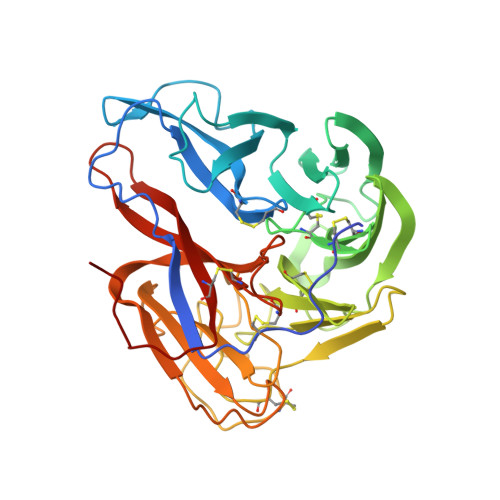Structural and functional characterization of neuraminidase-like molecule N10 derived from bat influenza A virus
Li, Q., Sun, X.M., Li, Z.X., Liu, Y., Vavricka, C.J., Qi, J.X., Gao, G.F.(2012) Proc Natl Acad Sci U S A 109: 18897-18902
- PubMed: 23012237
- DOI: https://doi.org/10.1073/pnas.1211037109
- Primary Citation of Related Structures:
4FVK - PubMed Abstract:
The recent discovery of the unique genome of influenza virus H17N10 in bats raises considerable doubt about the origin and evolution of influenza A viruses. It also identifies a neuraminidase (NA)-like protein, N10, that is highly divergent from the nine other well-established serotypes of influenza A NA (N1-N9). The structural elucidation and functional characterization of influenza NAs have illustrated the complexity of NA structures, thus raising a key question as to whether N10 has a special structure and function. Here the crystal structure of N10, derived from influenza virus A/little yellow-shouldered bat/Guatemala/153/2009 (H17N10), was solved at a resolution of 2.20 Å. Overall, the structure of N10 was found to be similar to that of the other known influenza NA structures. In vitro enzymatic assays demonstrated that N10 lacks canonical NA activity. A detailed structural analysis revealed dramatic alterations of the conserved active site residues that are unfavorable for the binding and cleavage of terminally linked sialic acid receptors. Furthermore, an unusual 150-loop (residues 147-152) was observed to participate in the intermolecular polar interactions between adjacent N10 molecules of the N10 tetramer. Our study of influenza N10 provides insight into the structure and function of the sialidase superfamily and sheds light on the molecular mechanism of bat influenza virus infection.
Organizational Affiliation:
School of Life Sciences, University of Science and Technology of China, Hefei 230027, China.


















